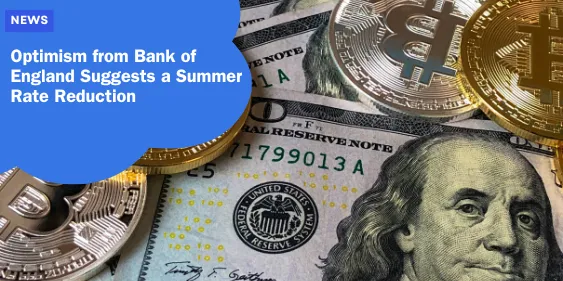Optimism from Bank of England Suggests a Summer Rate Reduction
Por: Maria Eduarda em September 12, 2024

As the United Kingdom continues to recover from the economic turbulence caused by the pandemic, the Bank of England’s actions regarding monetary policy are under intense scrutiny.
Inflation remains at 3.2%, and the persistent rise in living costs is a significant concern for households.
With the current interest rate at 5.25%, which has remained unchanged since the previous summer, the Bank’s stance is seen as pivotal in influencing the country’s financial outlook.
Led by Governor Andrew Bailey, the Bank of England’s decisions reflect the fine line it must walk between restraining inflation and promoting economic growth.
This interest rate, which has been held steady, directly influences borrowing costs for mortgages, loans, and savings returns.
Consequently, both businesses and individuals closely monitor the central bank’s movements.
Bailey’s recent statements regarding the economy carry an optimistic tone, and his hints at a potential interest rate reduction have ignited speculation.
Economists and analysts are carefully evaluating the Bank’s approach to uncover the factors that might prompt such a move.
The role of monetary policy in guiding the economic climate is of paramount importance, as adjusting interest rates directly impacts consumer spending, business investment, and overall economic activity.
Should a rate cut be implemented, borrowing may become more affordable, potentially spurring consumer and business spending.
Nonetheless, the decision to lower interest rates is fraught with complexities.
The Bank must weigh a host of economic indicators, including inflation forecasts, employment trends, and global market conditions, to ensure that any policy changes are both timely and effective.
The months ahead will bring further clarity as the nation awaits updates from the Bank of England.
The governor’s optimism about future rate cuts is likely to play a pivotal role in determining the UK’s economic trajectory.
With businesses and households feeling the financial pressure, the Bank’s forthcoming decisions will be closely scrutinized.
In the following sections, an in-depth analysis of the current economic climate, the forces behind rate decisions, and the implications of a possible summer rate cut will be provided, helping to paint a clearer picture of what to expect from the Bank of England and the UK’s financial future.
Current Economic Outlook
The Bank of England has maintained its interest rate at 5.25%, a figure that has remained constant since last summer.
This steady rate forms part of the Bank’s strategy to contain the surge in consumer prices and alleviate the strain of living costs for UK residents.
By keeping borrowing costs elevated, the Bank aims to suppress spending, thereby reducing demand for goods and slowing down the rate of price increases.
At present, inflation stands at 3.2%, which is above the Bank’s target of 2%.
However, Governor Andrew Bailey has expressed optimism that inflation will fall “close” to the target in the coming months.
This positive outlook is supported by encouraging developments within the economy and predictions of easing price increases.
The Bank’s decision to maintain its rate affects lending institutions and their customers alike.
Commercial banks base their lending rates on the central bank’s benchmark rate, which means borrowers are currently facing higher costs for loans and mortgages, while savers are enjoying improved returns.
This delicate balancing act between controlling inflation and fostering growth remains at the heart of the Bank’s decision-making.
Looking to the future, the Bank of England has released its projections for economic growth.
It forecasts 0.4% growth in the first quarter of 2024, followed by 0.2% from April to June.
These figures are slightly more positive than previous forecasts, in part due to a growing population and some policy measures from the government’s spring Budget, such as the reduction in National Insurance contributions.
Moreover, inflation is expected to follow a downward trajectory, potentially hitting 1.9% by 2026.
The combination of easing post-pandemic demand and stabilizing energy and food prices—exacerbated by geopolitical events like the war in Ukraine—supports this forecast.
Amid these economic challenges, the Bank of England remains vigilant in monitoring inflation trends and making necessary adjustments to ensure economic stability and growth.
With an election on the horizon, these economic conditions will likely play a central role in the political discourse, with Prime Minister Rishi Sunak remaining cautiously optimistic about the nation’s future.
Factors Influencing Rate Decisions
The Bank of England faces a challenging balancing act when setting interest rates.
A key consideration is the influence of post-pandemic demand.
The lifting of restrictions saw consumer spending rise sharply, leading to increased demand for goods and services, which in turn has contributed to inflationary pressures.
To temper this inflation, the Bank may need to raise interest rates, making borrowing more expensive and encouraging savings.
However, the Bank must also take into account the ongoing geopolitical risks, particularly the conflict in Ukraine.
This crisis has disrupted global supply chains and pushed up prices for essential goods such as energy and food, adding further pressure to inflation.
In response, central banks worldwide, including the Bank of England, have tightened monetary policy while trying to nurture economic growth.
This leads to the central issue: the trade-off between fostering economic growth and controlling inflation.
Raising interest rates could hamper business investment and slow down job creation, while allowing inflation to rise unchecked could erode consumer purchasing power and destabilize the economy.
Andrew Bailey has acknowledged this delicate balancing act, noting, “High interest rates can restrict economic growth, especially if businesses hesitate to invest or expand.”
will depend on the Bank’s assessment of the strength of post-pandemic demand, the geopolitical situation, and the balance between supporting growth and containing inflation.
Market vs. Bank Projections
The Bank of England’s current optimism contrasts with market expectations.
While the financial markets anticipate a rate reduction to 5% by August, followed by another drop to 4.75% by the year’s end, Andrew Bailey has hinted that more aggressive cuts may be necessary.
This divergence between market expectations and the Bank’s outlook introduces uncertainty into the timing and magnitude of rate cuts.
The Bank expresses cautious optimism due to positive signs of easing inflation, but officials emphasize the need for more evidence of sustained price stability before implementing any significant monetary easing.
The Monetary Policy Committee (MPC), which votes on interest rate adjustments, is showing a growing inclination towards a cut.
While two members of the committee recently voted in favor of reducing rates, the majority remain committed to holding them steady at 5.25%, indicating a wait-and-see approach for now.
This division highlights the complexity of the Bank’s decision-making process, as the committee must consider a wide range of factors.
A rate cut, possibly in June, would carry substantial implications for both borrowers and savers.
Borrowers would benefit from reduced mortgage payments and cheaper loans, while savers could see lower returns on their deposits.
Conclusion
In conclusion, the Bank of England’s positive outlook on inflation and growth raises the possibility of a rate cut as early as this summer.
Whether such a move occurs in June or later in the year, the central bank’s actions will directly impact both borrowers and savers across the UK. Individuals should stay informed of developments in monetary policy to make sound financial decisions, whether regarding mortgages, savings, or investments.
As the UK’s economy continues to evolve, the public must also remain engaged in discussions about economic policies to ensure a prosperous and stable future.






